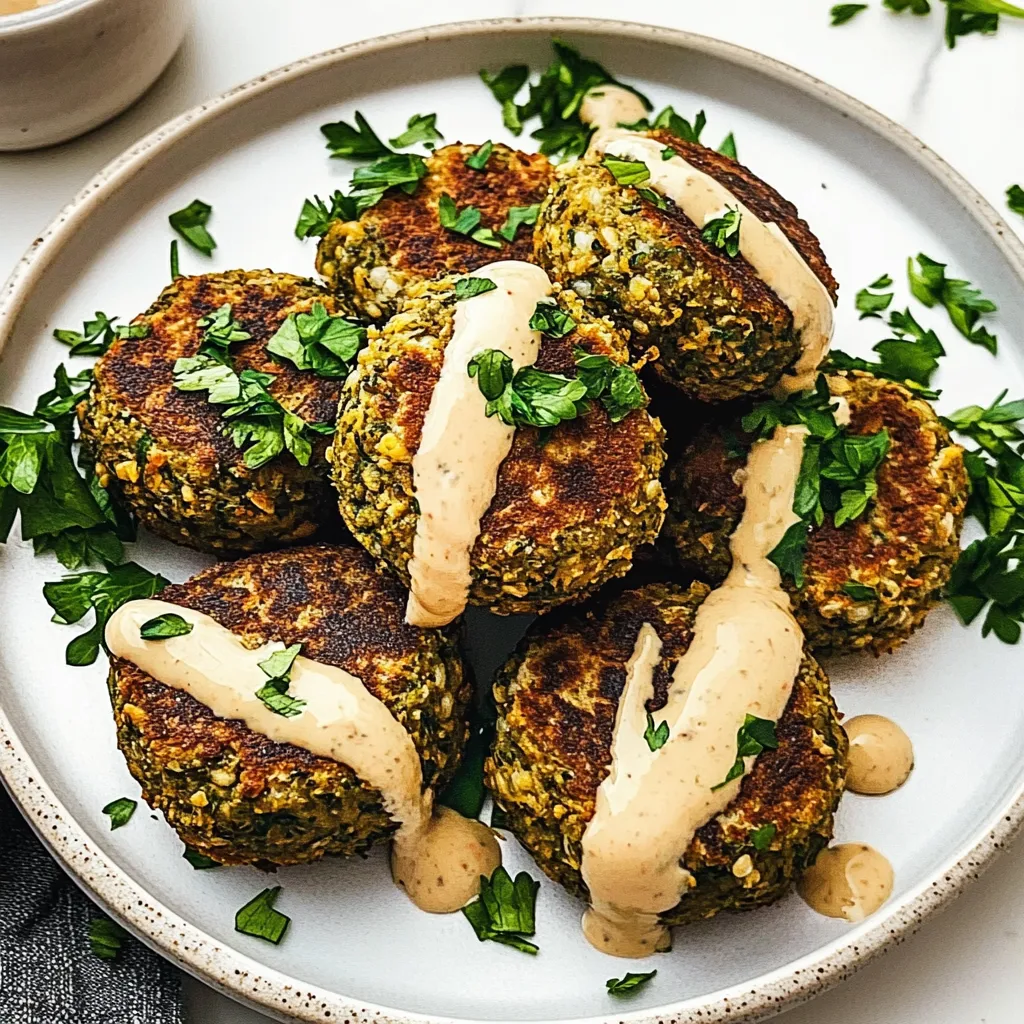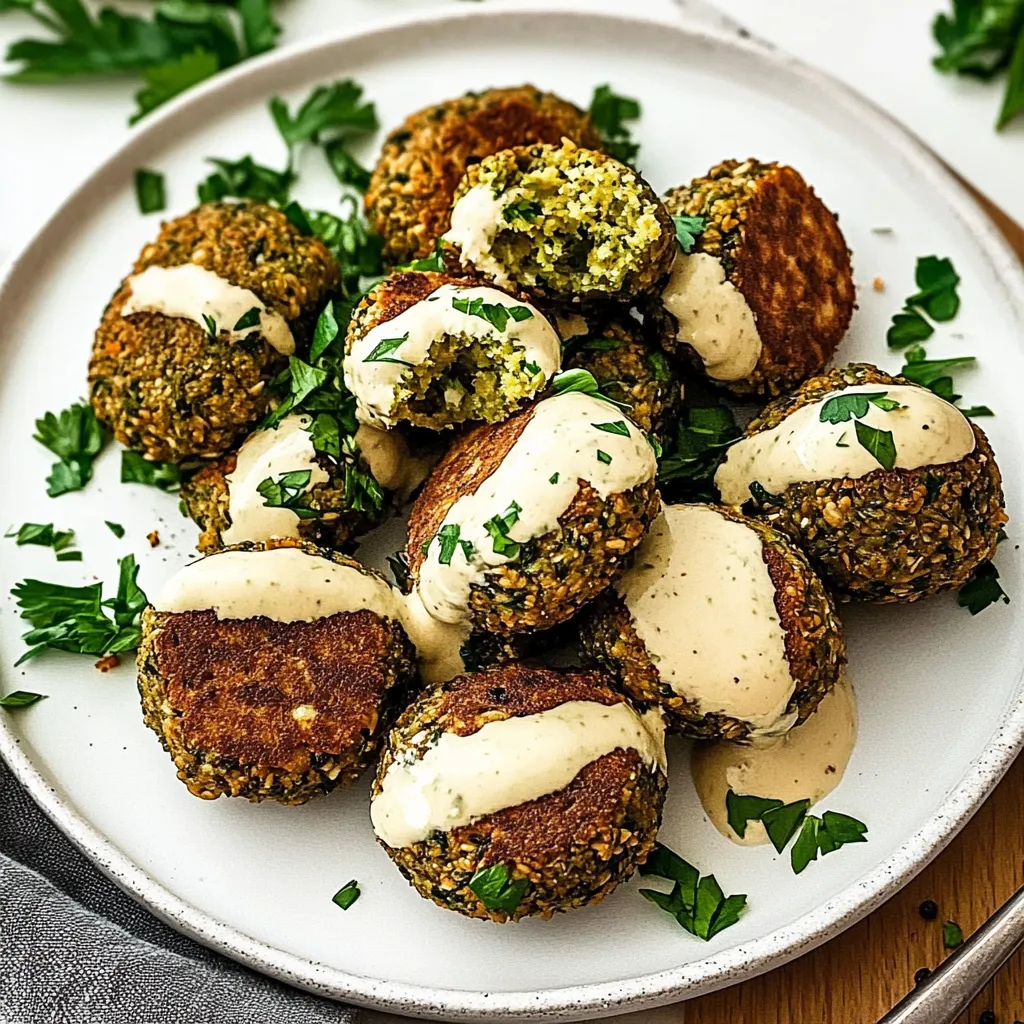Falafel: Delicious Chickpea Fritters Recipe

If you’re searching for a delightful blend of crunch and flavor, look no further than the beloved falafel. These little fried balls of goodness are not only a vegetarian staple but also a versatile dish that can fit into various cuisines. Made primarily from chickpeas or fava beans, they can easily be customized to suit your taste. From adding spices like cumin and coriander to incorporating fresh herbs such as parsley and mint, the possibilities are endless.
For those wishing to elevate their falafel game, consider experimenting with different baking methods instead of frying for a healthier twist, or try stuffing them into pita bread with a zesty tahini sauce. Regardless of how you choose to prepare them, ensuring that your mixture isn’t too wet is key to achieving that perfect texture. Join us on a culinary journey as we explore some innovative takes on this classic favorite, ensuring your next batch is irresistibly delicious!
Ingredients for Falafel:
To create a delicious batch of homemade falafel, perfect for serving 8–10 people, gather the following ingredients:
Pulses and Legumes
- 2 cups dried chickpeas (also known as garbanzo beans), soaked overnight
- 1/2 cup fresh parsley leaves, tightly packed
- 1/2 cup fresh cilantro leaves, tightly packed
- 1 medium onion, roughly chopped
Spices and Flavorings
- 4 cloves garlic, minced
- 2 teaspoons ground cumin
- 1 teaspoon ground coriander
- 1/2 teaspoon cayenne pepper (adjust to taste)
- 1 teaspoon baking powder
- Salt to taste, approximately 1 teaspoon
- Freshly ground black pepper to taste
Binding Ingredients
- 2 tablespoons all-purpose flour (adjust as needed for consistency)
- Vegetable oil for frying (approximately 4 cups, or as needed)
Serving Suggestions (Optional)
- Pita bread or flatbreads for serving
- Fresh vegetables, such as tomatoes, cucumbers, and lettuce
- Tahini sauce or tzatziki for drizzling
- Pickled turnips or radishes for added flavor
Variations and Alternative Ingredients
While classic falafel is made with chickpeas, you can experiment with other legumes:
- Substitute chickpeas with fava beans for a traditional Egyptian twist.
- Mix in spices like smoked paprika or sumac to enhance the flavor profile.
- Add 1/4 cup of cooked quinoa for added texture and nutrition.
These variations will not only offer different taste experiences but can also cater to different dietary preferences. Whether you’re looking to maintain a classic recipe or experiment with innovative flavors, these foundational ingredients will help you create a delicious, satisfying dish.

How to prepare Falafel:
To create delicious and crispy falafel, follow these simple steps.
Step 1: Soak the Beans
Begin by taking 1 cup of dried chickpeas and placing them into a bowl. Fill the bowl with enough water to cover the chickpeas completely. Allow them to soak overnight, or for at least 8 hours. This process softens the beans, making them easier to blend.
Step 2: Drain and Rinse
After soaking, drain the chickpeas and rinse them under cold water. Make sure to remove any loose skins or debris. This helps improve the texture of your mixture.
Step 3: Prepare the Herb Mixture
In a food processor, combine the soaked chickpeas, 1 small onion (chopped), 3 cloves of garlic (minced), and a handful of fresh parsley and cilantro. This herb blend adds vibrant flavor to your mixture.
Step 4: Season the Mixture
Add 1 teaspoon of ground cumin, 1 teaspoon of ground coriander, ½ teaspoon of baking soda, and a pinch of salt and pepper to the food processor. These spices enhance the aroma and taste of your falafel.
Step 5: Blend the Ingredients
Pulse the food processor a few times until the mixture is finely chopped but not pureed. You want it to be a slightly coarse texture for better results.
Step 6: Rest the Mixture
Transfer the mixture to a bowl and cover it with plastic wrap. Let it rest in the refrigerator for at least 30 minutes. This helps the flavors meld together and improves the texture.
Step 7: Shape the Falafel
Using your hands, form the mixture into small balls or patties about the size of a golf ball. Make sure they are compact to prevent them from falling apart during frying.
Step 8: Preheat the Oil
In a deep frying pan, heat about 3 inches of vegetable oil over medium heat until it reaches 350°F (175°C). Test the oil by dropping a small piece of batter; if it sizzles, it’s ready.
Step 9: Fry the Falafel
Carefully place the formed falafel in the hot oil, working in batches. Fry them for 3-4 minutes on each side until they turn golden brown. Adjust the heat as necessary to prevent burning.
Step 10: Drain and Serve
Once golden, remove the falafel and place them on a paper towel-lined plate to drain excess oil. Serve hot with tahini sauce or in pita bread with fresh vegetables. Enjoy your homemade treat!
Tips for the Perfect Falafel
Making delicious falafel requires attention to detail. Here are some practical tips to help you achieve that perfect texture and flavor, ensuring your dish impresses everyone at the table.
Maintain the Right Temperature
One of the biggest challenges when frying is achieving the right oil temperature. Heat your oil to about 350°F (175°C) before adding your falafel balls. If the oil is too cold, the mixture will absorb too much oil, making your falafel greasy and dense. Conversely, if the oil is too hot, the outside may burn before the inside cooks properly. Use a deep-fry thermometer to keep an eye on the temperature for the best results.
Use Quality Ingredients
Choosing fresh, high-quality ingredients makes a significant difference in flavor. Opt for dried chickpeas instead of canned ones for a firmer texture. Soak the chickpeas overnight to ensure they soften properly. Fresh herbs like parsley and cilantro contribute to a vibrant taste, while spices such as cumin and coriander enhance the depth of flavor. Remember, fresh ingredients result in tastier falafel.
Consider Dietary Substitutions
If you’re catering to specific dietary restrictions, you can easily adapt your falafel recipe. For a gluten-free version, ensure that your ingredients, including any flour used for binding, are gluten-free. Additionally, for a vegan twist, skip the egg typically used as a binder. Instead, try adding a flaxseed meal or chia seed mix to act as a binder. Lastly, if you’re looking to reduce fat, consider baking your falafel instead of frying. Just make sure to brush them lightly with oil to achieve a crispy texture.
Perfecting Texture and Flavor
For a crisp exterior and soft interior, avoid over-processing your chickpeas in a food processor. Pulse until the mixture is just combined, allowing for a slight grainy texture. This provides that signature bite that everyone loves. Also, let the mixture rest for about 30 minutes before forming into balls or patties. This rest period allows the flavors to meld and the mixture to firm up, resulting in better-formed falafel.
By following these tips, you can create a falafel that’s not only delicious but perfect for sharing. Enjoy experimenting with flavors, ingredients, and cooking methods to find your ideal version!
Storage Tips for Falafel:
Storing falafel correctly ensures you enjoy its delightful flavors and crispy texture even after the initial cooking. Follow these storage tips to maintain its freshness, texture, and taste for a longer period.
Optimal Storage Conditions
Begin by allowing the cooked falafel to cool down completely at room temperature. This helps prevent condensation, which can make them soggy. Once cooled, arrange the falafel in a single layer on a baking sheet lined with parchment paper. This technique keeps them from sticking together and preserves their shape. Place the baking sheet in the freezer for about 1-2 hours, or until the falafel are firm.
Storing in the Freezer
After freezing, transfer the falafel to an airtight container or a resealable freezer bag. Remove as much air as possible before sealing. Label the container or bag with the date for future reference. Properly stored, your falafel can last in the freezer for up to three months without losing quality. When you are ready to enjoy them, simply reheat from frozen in the oven or air fryer to regain that crispy exterior.
Refrigeration of Falafel
If you plan to consume the falafel within a few days, store it in the refrigerator. Place them in an airtight container lined with paper towels to absorb excess moisture. This helps keep the texture intact. Refrigerated falafel usually stays fresh for about 3-5 days. When ready to eat, consider reheating on a skillet or in the oven to restore crispiness.
Leftover Sauces and Accompaniments
Don’t forget about sauces or dips that often accompany falafel. Store leftovers in separate airtight containers. Most sauces, such as tahini or tzatziki, can remain fresh in the fridge for up to a week. Check labels for specific shelf life if using store-bought condiments.
Proper storage keeps falafel delightful, whether you enjoy them fresh or save them for later. Following these tips helps ensure you savor every crispy bite, whether at a gathering or a casual meal at home.
Related Recipes
If you enjoy the tasty, crispy goodness of falafel, you might also love these complementary dishes that share similar flavors or ingredients. Each recipe brings its unique twist while complementing the essence of falafel.
- Hummus: This classic Middle Eastern dip made from blended chickpeas, tahini, lemon, and olive oil pairs wonderfully with falafel. Its smooth texture and earthy flavor create a delightful contrast when served together. Hummus serves as a dipping sauce, enhancing the overall taste experience.
- Pita Bread: Soft and warm pita bread is perfect for holding falafel or creating a sandwich with it. The bread’s mild flavor and pocket-like shape allow for easy filling, making your meal convenient and delicious. Enjoy it alongside your meal for a complete experience.
- Tabbouleh: This vibrant salad, made primarily of parsley, tomatoes, bulgur, and a sprinkle of mint, adds freshness to any dish. Its bright flavors and crunchy texture balance the richness of falafel. The refreshing bite of tabbouleh complements the spiciness and heartiness of chickpeas.
- Baba Ganoush: A creamy dip made from roasted eggplant, garlic, and tahini, baba ganoush offers a smoky taste that pairs excellently with falafel. The combination of flavors can elevate your meal. Enjoy it as a spread or dip for a luscious accompaniment.
- Greek Salad: This salad combines tomatoes, cucumbers, olives, and feta cheese, creating a refreshing side that enhances the meal. Its tangy dressing and crisp vegetables provide a zesty counterpart to the deep-fried balls.
Each of these recipes can enhance your dining experience, making them perfect companions to savor alongside falafel.
Frequently Asked Questions:
What are the main ingredients in falafel?
The traditional ingredients for this popular Middle Eastern dish primarily include chickpeas or fava beans, which are often combined with herbs like parsley and cilantro. Spices such as cumin and coriander typically add depth to the flavor, while garlic gives it an aromatic kick. The mixture is formed into small balls or patties and fried until golden and crispy, creating a delightful texture that complements its rich taste.
Are falafels gluten-free?
Yes, falafels can be naturally gluten-free, making them suitable for those with gluten sensitivities or celiac disease. However, it is crucial to ensure that any accompanying ingredients, such as sauces or bread, are also gluten-free. When making these savory snacks at home, using gluten-free breadcrumbs or alternative binders can help maintain their integrity while keeping the dish fully gluten-free.
How can I serve falafel?
These delicious fried balls can be served in a variety of ways. One popular serving method is within pita bread, often accompanied by fresh vegetables like tomatoes, cucumbers, and lettuce. Additionally, a drizzle of tahini sauce or a dollop of yogurt enhances the flavor profile. Furthermore, falafels can be plated with salads, or served on their own as appetizers or snacks, showcasing their versatility.
Can falafel be made ahead of time?
Absolutely! Preparing falafel in advance is a practical option for meal planning. You can form the patties or balls and refrigerate them for a day or two before cooking. Alternatively, they can also be frozen and later fried or baked. This method allows for quick and easy preparation without sacrificing taste or texture when you’re ready to serve them.
Is there a vegetarian alternative to falafel?
While falafel is already vegetarian-friendly, there are alternatives for those seeking plant-based options. For instance, you can try lentil patties or batters made with black beans, quinoa, or even sweet potatoes. Each variation can be seasoned and cooked similarly to traditional falafel, offering unique flavors and textures while remaining meat-free.
What is the best way to cook falafel?
While deep frying is the classic method to achieve maximum crispiness, there are healthier alternatives like baking or air frying that can yield delicious results. Baking requires less oil, making it a lighter option. Whichever cooking method you choose, ensuring the oil is hot enough for frying can help achieve the perfect crunchy exterior while keeping the inside moist and flavorful.
Conclusion:
Creating delicious falafel at home is a straightforward process that allows for endless customization. This versatile dish not only caters to various dietary preferences but also invites creativity in flavors and textures. Emphasizing the use of simple ingredients like chickpeas, herbs, and spices, the recipe encourages experimentation with different seasonings and toppings, ensuring everyone can tailor their own version to suit their taste. Whether served in pita pockets, on salads, or as a snack with dips, the simplicity of preparation makes falafel a go-to option for both quick meals and gatherings. Remember, the key to a perfect falafel lies in the soaking and blending of ingredients, so take your time to get it just right. With this foundation, your culinary journey can explore an array of global flavors while keeping healthy eating enjoyable and accessible.
Print
Falafel: Delicious Chickpea Fritters Recipe
- Total Time: 25 minutes
- Yield: 12-15 falafel pieces 1x
Description
Crispy on the outside, tender inside — classic falafel that’s perfect for wraps, salads, or snacks.
Ingredients
-
1 cup dried chickpeas (soaked overnight)
-
1 small onion, chopped
-
2 cloves garlic
-
1/4 cup fresh parsley
-
1 tsp ground cumin
-
1 tsp ground coriander
-
1/2 tsp salt
-
1/4 tsp black pepper
-
Oil for frying
Instructions
-
Blend chickpeas, onion, garlic, parsley, and spices in a food processor until coarse.
-
Form mixture into small balls or patties.
-
Heat oil in a pan and fry falafel until golden and crispy, about 3-4 minutes per side.
-
Drain on paper towels and serve warm.
Notes
-
Do not use canned chickpeas — soak dried for best texture.
-
For a healthier version, bake at 375°F (190°C) for 20-25 minutes, flipping halfway.
-
Serve with tahini sauce or yogurt dip.
- Prep Time: 15 minutes (+ soaking overnight)
- Cook Time: 10 minutes
Nutrition
- Calories: 180kal
- Fat: 7g
- Carbohydrates: 20 g
- Fiber: 5g
- Protein: 7g
